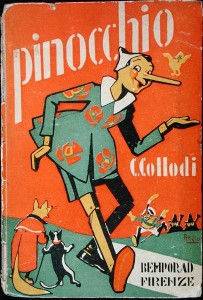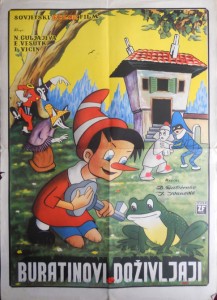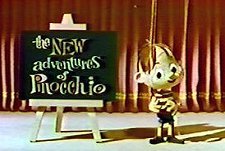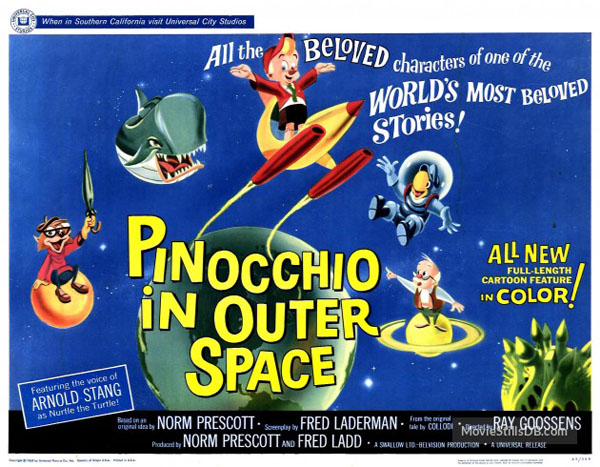 The earliest movie that I can remember seeing was Walt Disney’s Pinocchio, in its October 1945 re-release when I was 4 years old. So I have always had an interest in animated versions of Collodi’s 1881-’83 children’s classic. It was written as an Italian newspaper’s weekly children’s supplement, so the story wandered widely; but its main events have been included in most of the live-action and animated movies, TV productions, stage plays and musicals, a grand opera, etc. Pinocchio has clearly become one of the most frequently adapted literary works in animation, including all of its cinematic sequels and variations like Pinocchio in Outer Space.
The earliest movie that I can remember seeing was Walt Disney’s Pinocchio, in its October 1945 re-release when I was 4 years old. So I have always had an interest in animated versions of Collodi’s 1881-’83 children’s classic. It was written as an Italian newspaper’s weekly children’s supplement, so the story wandered widely; but its main events have been included in most of the live-action and animated movies, TV productions, stage plays and musicals, a grand opera, etc. Pinocchio has clearly become one of the most frequently adapted literary works in animation, including all of its cinematic sequels and variations like Pinocchio in Outer Space.
The first cinematic adaptation of Pinocchio was a December 1911 live-action movie directed by Giulio Antamoro, released as a Christmas extravaganza in Austria-Hungary, France, Germany, Spain, and the U.K. – but not in Italy, where it was made. Pinocchio was also intended to be the first Italian animated feature in 1936, Le avventure di Pinocchio, but it was never finished.
Many animated adaptations, especially the Italian, have followed the illustrations by Attilio Mussino for the 1911 book collection of the newspaper serialization. Many adaptations have also followed Collodi’s depiction of the wooden puppet as a thorough brat rather than the innocent boy as in Disney’s version. Still others are adaptations of the 1936 Russian-Soviet version by Aleksei Tolstoy, or are a mixture of Collodi’s and Tolstoy’s versions.
Pinocchio, directed by Noburo Ōfuji. December 1932.
A lost film. All that is known about it today is that it was in stop-motion, was in production from 1929 to 1932, had 52 animators, and was described both as the first animated feature and as the longest animated film at the time. Even assuming that the writers did not know about Cristiani’s Argentine 1917 El Apóstol, it must have been at least 30 minutes long. A 1960 Italian description was: “Strange to say, the first attempt to design an animated Pinocchio was an Oriental Pinocchio with almond eyes, a Mongol Gepetto, a Fairy With Turquoise Hair who resembled a sweet geisha, and a green fisherman who looked more like a bearded samuraj (written with a j)”. This Pinocchio was divided into three parts, some of which included tinting. (The “green fisherman” was presumably actually green.)
 Pinocchio, directed by Ben Sharpsteen & Hamilton Luske. 88 minutes. February 7, 1940.
Pinocchio, directed by Ben Sharpsteen & Hamilton Luske. 88 minutes. February 7, 1940.
The story of Walt Disney’s second animated feature needs no repeating here. In fact, I highly recommend you read J.B. Kaufman’s recent authoritative history of the film. As I’ve said, I consider it to be the earliest movie that I saw based on its first re-release in October 1945, despite my mother insisting that it was Bambi because she took me as a babe in arms when she saw it during its August 1942 release. I was less than 2 years old then and I don’t remember it at all. I probably was taken by my parents to other, adult live-action movies before October 1945, but Pinocchio is the earliest movie that made an impression on me.
Its next re-release was in February 1954. I was just 13, and our grandmother took me and my two younger sisters to see it at the Mesa Theater, about a mile from home. I liked it so much that when it was over and we prepared to leave, I argued successfully to be allowed to stay and see it again, and to walk home alone afterward.
Some confusion over the movie’s title has been due to the title in its trailer as “Walt Disney’s Pinocchio“, but in the movie itself, it’s just Pinocchio.
 Priklyucheniya Buratino (The Adventures of Buratino), directed by D. Babichenko, I. Ivanov-Vano and Mikhail Botov. 68 minutes. January 4, 1960.
Priklyucheniya Buratino (The Adventures of Buratino), directed by D. Babichenko, I. Ivanov-Vano and Mikhail Botov. 68 minutes. January 4, 1960.
This is “based on a tale by A. Tolstoy”, but with a woodcarver, a live puppet, a talking cricket, a fox and a cat, the use of Italian names, etc., you can tell where it’s coming from.
Soyuzmultfilm’s feature is quite charming, nevertheless. There are differences; for instance, Buratino has a long and sharp nose because it’s carved that way, not because it grows with lying.
This film is a traditionally drawn animated remake of a Russian live action (with occasional stop-motion animated puppets) feature The Little Golden Key (1939).
Co-director Ivan Ivanov-Vano was one of Russia’s most celebrated directors of animation. His 1947 feature The Little Humpbacked Horse (aka The Magic Pony) has become an international classic.
The New Adventures of Pinocchio, directed by Arthur Rankin, Jr. and Jules Bass. 130 5-minute episodes. 1960 to 1961.
 The credits said that Arthur Rankin and Jules Bass were the directors (also producers), but they should have listed Tadahito Mochinaga as a director as well. This was the first “Animagic” production of Rankin & Bass’ Videocraft International Ltd. in the U.S. and Dentsu Studios in Japan; actually produced in stop-motion puppetry by Mochinaga at his MOM Productions in Tokyo.
The credits said that Arthur Rankin and Jules Bass were the directors (also producers), but they should have listed Tadahito Mochinaga as a director as well. This was the first “Animagic” production of Rankin & Bass’ Videocraft International Ltd. in the U.S. and Dentsu Studios in Japan; actually produced in stop-motion puppetry by Mochinaga at his MOM Productions in Tokyo.
The series consisted of 130 5-minute episodes, that could be combined into 5-chapter 25-minute episodes if the TV station preferred. Since the program was syndicated, it appeared in different cities during 1960 to 1961 and did not have a specific release date; it was considered as in reruns after 1961. It avoided comparisons with Disney’s Pinocchio as much as possible, and was presented as Gepetto’s telling of Pinocchio’s and (no name) Cricket’s all-new adventures while looking for the Blue Fairy. The only other regular characters were Foxy Q. Fibble, the con-man fox; Cool S. Cat, a beatnik cat; Pedro Pistol, a private eye, and Simoro, Pistol’s English bloodhound.

Pinocchio in Outer Space, directed by Ray Goossens. 71 minutes. December 22, 1965.
Pinocchio in Outer Space was mentioned in my columns on French-language animation. It was produced by Brussels’ Belvision Studio, and it was released in Belgium and France, but it was financed and produced primarily by Fred Ladd and Norm Prescott for the American release. It was made to take advantage of the current interest in rockets, artificial satellites, space, and secret agents. It may be most important for leading to Ladd’s adaptation of Japan’s Tetsuwan Atom TV series for America and the rest of the world as Astro Boy, who was a sort of robot Pinocchio of the future. (Pinocchio in Outer Space itself was quickly forgotten.)
The Blue Fairy lives with her mother near the Moon, where they are bothered by Earth’s artificial satellites whizzing around them. She tells her mother that Pinocchio went back to acting so badly as a boy that she turned him back into a puppet. Pinocchio still lives with Gepetto, who now has a dog named Fedora. They see a newscast on television that Astro, a space whale, has been destroying Earth’s rockets and satellites. NASA has offered a reward for his capture. Next day Pinocchio, walking to school, wishes that he could capture the whale and give the reward to Gepetto. The fox and cat, now beatniks named Sharp and Groovy, fast-talk him into buying with his lunch quarter a “how to hypnotize your friends” booklet to catch Astro, without describing how he’s to get into space to do this. Next a UFO conveniently lands right by Pinocchio with Nurtle the Turtle (voiced by Arnold Stang), although he complains that he’s really a space being called a “twertle” from the planet Twertledee (near Twertledum). He’s also a secret agent sent to investigate strange radiation coming from lifeless Mars – he landed on Earth by mistake. Pinocchio warns him about Astro as a space hazard, and offers to hypnotize Astro if the whale attacks him, if Nurtle will take him to Mars.
 The movie gets very educational with explanations by Nurtle to Pinocchio about solar flares, Mars’ lighter gravity, two moons, etc. Amidst this is the point that Pinocchio, being a puppet, does not need a space helmet to breathe like Nurtle does. On Mars they are menaced by giant mutant sand crabs, and discover the ruins of a city, with a newer but still dead city beneath it. More giant lizards, scorpions, etc. attack them, including whalelike fish from an underground river. Nurtle theorizes that the Martians were mutating animals into giants for warfare, and that one of the whale-fish grew so large that it escaped into space and returned to destroy the city so all the air escaped. A giant marsquake and sandstorm end sand into a nuclear reactor, and Pinocchio and Nurtle escape into space just as the reactor explodes.
The movie gets very educational with explanations by Nurtle to Pinocchio about solar flares, Mars’ lighter gravity, two moons, etc. Amidst this is the point that Pinocchio, being a puppet, does not need a space helmet to breathe like Nurtle does. On Mars they are menaced by giant mutant sand crabs, and discover the ruins of a city, with a newer but still dead city beneath it. More giant lizards, scorpions, etc. attack them, including whalelike fish from an underground river. Nurtle theorizes that the Martians were mutating animals into giants for warfare, and that one of the whale-fish grew so large that it escaped into space and returned to destroy the city so all the air escaped. A giant marsquake and sandstorm end sand into a nuclear reactor, and Pinocchio and Nurtle escape into space just as the reactor explodes.
They are returning to Earth when Astro appears and swallows them. They escape through Astro’s blowhole, but the UFO’s stabilizer is bent. Astro attacks again, but the bent stabilizer makes the UFO wobble so much that Astro is hypnotized. They take him back to Earth, but realize too late that they will burn up when they enter Earth’s atmosphere. The UFO escapes, but Astro seems doomed until Pinocchio, who does not need a spaceship, sacrifices himself to save the whale. The Blue Fairy brings Pinocchio back to life and turns him into a real boy again to reward him. The movie ends with a big celebration at which Pinocchio and Nurtle are given awards, and Astro is now friendly.
Next Week: Pinocchio in Animation – Part 2.


 Fred Patten (1940-2018) was an internationally respected comics and animation historian. He has written about anime or comic books for publications ranging from Animation Magazine and Alter Ego to Starlog. He was a contributor to The Animated Movie Guide (2005), and is author of Watching Anime, Reading Manga (2004, Stone Bridge Press), a collection of his best essays, and Funny Animals and More (2014, Theme Park Press), based upon his early columns here on Cartoon Research. He passed away on November 12th, 2018.
Fred Patten (1940-2018) was an internationally respected comics and animation historian. He has written about anime or comic books for publications ranging from Animation Magazine and Alter Ego to Starlog. He was a contributor to The Animated Movie Guide (2005), and is author of Watching Anime, Reading Manga (2004, Stone Bridge Press), a collection of his best essays, and Funny Animals and More (2014, Theme Park Press), based upon his early columns here on Cartoon Research. He passed away on November 12th, 2018.





































Regarding Rankin-Bass/Videocraft’s NEW ADVENTURES OF PINOCCHIO: A short article announcing the series in the February 13, 1961, issue of Broadcasting Magazine notes that initial sales had been made to stations in twelve markets, and that the series had begun airing on some of those stations the previous week. By the time a follow-up article appeared on May 15, the series had been sold in fifty markets, with more than seventy of the one hundred thirty planned episodes then available, and the rest due by October.
You mean that it wasn’t shown during 1960 at all? Aha! Important original animation research!
I should have stated that this list is NOT going to be complete. It will include only highlights; the major animated productions in feature films and television series. It will not include shorts, half-hour TV specials, and the many instantly-forgettable made-for-DVD “movies”.
First on the Soyuzmultfilm version I’ve only seen clips of “Buratino” on XCHG TV 5 from Mexico via Big Dish Satellite back in the 1990’s when it was aired in the holiday season (or when school was out on vacation there). This version was by a little known video distribution company called Kidco Videos which didn’t show the complete movie. The one scene I remember was a scene where “Buratino” was in the Land of the Undead and there was a cart being drawn by a young skeleton goat.
And in Pinocchio in Outer Space ….GAAAAAAAAAAAH!!!!!!!!!!!!
In my opinion the film had a very poor plot line (we don’t know how “Astro ” became a Rouge Killer Space Whale and what made “Astro ” to turn on his Martian captors and terrorize the Galaxy).
And the song “Goody Good Morning ” by far in my opinion it was one of the worst song ever written for a animated movie (And that was years before It’s Party Time that was preformed by that Rapping Dog in 1912 England in Titanic, the Legend Goes On).
And if Pinocchio in Outer Space would of took place today you can expect the protesters from PETA demanding the liberation of Astro the Rouge Space Whale from captivity.
And in Pinocchio in Outer Space ….GAAAAAAAAAAAH!!!!!!!!!!!!
Haha!
In my opinion the film had a very poor plot line (we don’t know how “Astro ” became a Rouge Killer Space Whale and what made “Astro ” to turn on his Martian captors and terrorize the Galaxy).
The film is guilty of that ambiguity, but I sorta liked where it was going there despite being very unclear of the demise of an entire planet’s civilization. I suppose had needed more clarification, Pino and Nertle could’ve stumbled upon a dairy or maybe a video monitor where the exposition is laid out for them so they didn’t have to guess how it happened. It could easily just a video recording of a scientist sending out a distress message to whoever may be watching this not to make the same mistake they did just before the whale shows up and the recording is cut off.
And the song “Goody Good Morning ” by far in my opinion it was one of the worst song ever written for a animated movie (And that was years before It’s Party Time that was preformed by that Rapping Dog in 1912 England in Titanic, the Legend Goes On).
Every animated feature back then always had to have the one song that grates on your ears and you wish it never existed.
And if Pinocchio in Outer Space would of took place today you can expect the protesters from PETA demanding the liberation of Astro the Rouge Space Whale from captivity.
I bet, or hope if he was freed, he’d stay a certain distance away from our Solar System, but fat chance on that!
I have the DVD with the producer’s commentary. He’s still pretty proud of it.
It was a strange film. The “science” existed alongside standard cartoon logic (how does Astro breathe and spout flames in a vacuum?), and it goes from a cutesy comic opening sequence to surprisingly grim stuff on Mars (we see a big monster feeding from the tanks were the baby monsters were kept).
An image gallery includes what looks like the design for a parade float, which took me back to the days when the various big parades — especially Macy’s — had floats promoting Big Holiday Movies. Did PIOS actully turn up in a parade? For that matter, was it a big national release?
I have the DVD with the producer’s commentary. He’s still pretty proud of it.
Who wouldn’t! At least it wasn’t a “changed my mind” moment for him years down the road.
It was a strange film. The “science” existed alongside standard cartoon logic (how does Astro breathe and spout flames in a vacuum?), and it goes from a cutesy comic opening sequence to surprisingly grim stuff on Mars (we see a big monster feeding from the tanks were the baby monsters were kept).
It’s certainly a mess story-wise, at least, combining a familiar character with a Sci-Fi plot out of whatever was bit at the time (or before, I know Rocketship X-M gave us a Mars that resorted to barbarism after an atomic war).
An image gallery includes what looks like the design for a parade float, which took me back to the days when the various big parades — especially Macy’s — had floats promoting Big Holiday Movies. Did PIOS actully turn up in a parade? For that matter, was it a big national release?
I believe it did. While I don’t remember where I saw this from, there was a home movie of a parade that showed a space ship float with what might’ve been Arnold Stang himself dressed in a spaceman outfit, but I could be wrong.
We watched New Adventures of Pinnochio way back in the 70’s on CBC, it was okayish, very Rankin Bass thru and thru. Haven’t seen it in 40 yrs.
I have vague memories of the “New Adventures of Pinocchio” running on KTLA (Channel 5) in Los Angeles, as part of the afternoon kid show hosted by “Skipper” Frank. These cartoons were dropped in alongside the A.A.P package of color “Merrie Melodies”, and NTA’s package of Max Fleischer and Famous Studios cartoons. (including Little Lulu, Gabby and the Stone Age Cartoons).
Don’t remember much about the cartoons per se, except for one episode ttle: “It’s Cool In The Cooler”.
@Chris Sobieniak
Could that home movie footage featuring the spacecraft/Rocket Ship from Pinocchio in Outer Space featuring Arnold Stang might be from Hollywood’s Santa Claus Lane Parade (Now the Hollywood Christmas Parade)? Since the Santa Claus Lane Parade/Hollywood Christmas Parade is usually used to promote major films (that are already in theaters or that are coming soon to theaters) with the stars of those films appearing in the parade.
The only animated version of Pinocchio mentioned here I’ve seen is the classic Disney version (I still remember being,at age six,absolutely terrified by Lampwick’s transformation into a donkey). I’ve never seen Pinocchio in Outer Space,but it does remind me somewhat of Toei’s Gulliver’s Travels Beyonf the Moon,which was made at the same time (and a young Hayao Miyazaki was a key animator on). Will you be doing Gulliver’s Travels in animation in the near future?
Both Pinocchio in Outer Space and Gulliver’s Travels Beyond The Moon do follow a similar theme of what I call “literary characters in space”. They bother certainly complement each other as a double feature.
I am not currently planning a column on Toei’s “Gulliver’s Travels Beyond the Moon”. The mid-1960s were only a decade beyond the mid-1950s, when science still thought that Venus was a steamy jungle, Mars was a desert with a sparse but definite atmosphere, and Jupiter was a solid planet instead of gaseous. In other words, our ideas about the planets were changing dramatically at the time.
Actually Fred, I meant the various animated versions/variations of Jonathon Swift’s Gulliver’s Travels,not just the 1965 Toei feature. Perhaps including Hanna-Barbara’s New Adventures of Gulliver series from 1969.
The co-producer of “Pinocchio in Outer Space” was the same Norm Prescott who co-founded Filmation. He had previously been a DJ in Boston (and was a sidekick to Bob and Ray in their early years in that city).
I’d be very interested in seeing a contemporary source on Ôfuji Noburo’s film “Pinocchio” (1932). Everyone seems, in the end, to refer to Gianeri’s history of animation from 1960. The Japanese don’t seem to know this film at all, despite its alleged success. Moreover, to have been considered the longest animated film at the time, it would have had to beat Lotte Reiniger’s silhouette animation “Die Abenteuer des Prinzen Achmed” (1926, 65 min.) which was known in Japan, too. Personally, I don’t think a Pinocchio film by Ôfuji ever existed.